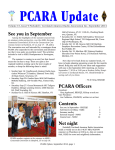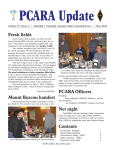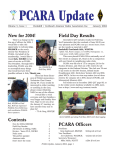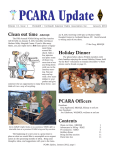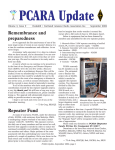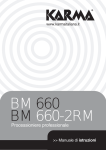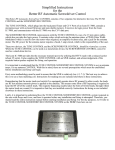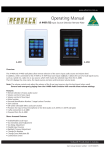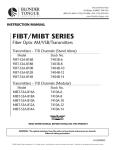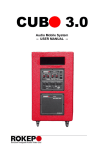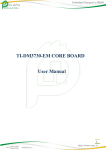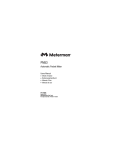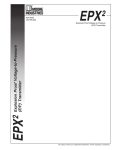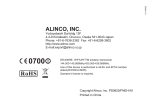Download External keypad
Transcript
External keypad pin 6 (GND) of the 8-pin round microphone plug when a memory button is pressed. If you have an Icom HF transceiver, then you might find this project of interest — build yourself an external keypad for around $34.00. Key memories Recent Icom HF transceivers — such as the IC-7410A and IC-7000 — have a built-in electronic memory keyer capable of storing up to four messages. Some models also have a voice keyer to record short voice announcements. The memory keyer can be helpful for sending your callsign and standardized contest exchanges — for example “CQ CQ de W2NYW W2NYW” and “2A ENY”. Calling up the stored memories is carried out using “soft keys” positioned around the display. You need to be in the correct part of the radio’s menu system before these options appear. On the IC-7410, the sequence is to select “CW” mode, press the “Menu” button to reach Menu M1, press the F-4 “KEY” selection, then press the F-2 “SEND” function-key. The four memory keys “M1”, “M2”, “M3” and “M4” then appear on the display. This Icom IC-7410 display showing “MENU” key and function keys F-1 to F-5, ready to send from the four CW memories. is not very convenient, especially if you want to use the function keys for some other purpose such as the Band Scope. Plug-in shortcut Fortunately, Icom allows connection of an external keypad to call up memory keyer contents at any time. This keypad is normally plugged into the transceiver’s “MIC” connector, which will either be a screwon 8-pin round type or an 8-pin modular jack type. Icom does not sell a suitable external keypad as an accessory for their HF transceivers but they do provide the circuit diagram for an external keypad in the IC-7410 Instruction Manual — four different resistor values are connected between pin 3 (UP/DOWN) and Schematic from Icom IC-7410 User Manual for an External Keypad that can access the four stored memories. In recent years, the “BetterRF Company” sold an “i-Mate” external keypad for Icom radios. The i-Mate cost $85 and was wired between the existing microphone and the radio’s MIC connector. Unfortunately BetterRF does not seems to be in business any more. The i-Mate external keypad was manufactured by BetterRF. Do it yourself I decided to build my own external keypad, but first I needed a suitable case for mounting the microphone connectors plus the four push-buttons for selecting memory contents. At a recent hamfest I had spotted an MFJ-1251 “Universal Microphone Converter”. This is a small metal box with front panel connectors for both an 8-pin round microphone plug and for an 8pin modular plug. Separate cables are provided for conMFJ-1251 Microphone Control necting the Center from MFJ Enterprises. adapter to either type of MIC socket on the radio. The MFJ adapter allows one manufacturer’s microphone to be used with another manufacturer’s radio, which is often wired differently. Headers and jumpers inside the case allow for a variety of interconnections, so that (for example) an Alinco microphone with a modular plug could be used with an PCARA Update, September 2014, page 9 Icom radio having an 8-pin round MIC socket. I thought the MFJ-1251 would provide a good basis for my external keypad. At the ARRL Centennial Convention in Hartford I purchased an MFJ-1251 adapter from MFJ’s own booth. The price was $29.95. Next day I purchased a packet of four momentary pushbutton switches from Radio Shack — part number 275-1547, price $3.99. These are the ‘normally open’ type. Total so far — $33.94. Radio Shack momentary pushbutton switches. The right connections The first task was to evaluate the circuitry of MFJ’s Universal Microphone Adapter. MFJ provides an Instruction Manual containing the schematic plus connection diagrams for various combinations of microphone plug and radio manufacturer. My plan was to use the Icom radio’s original HM-36 microphone with the matching 8-pin round MIC socket on the Icom transceiver. Unfortunately that straight-through combination is not included in the manual. (Not unexpected though!) Careful examination of the schematic showed that MFJ selects four wires coming in from the microphone for MIC-GND, MIC-AUDIO, MIC-PTT plus the 8 volt DC feed to power any microphone circuitry, labeled THRU/PASS. These four lines are then connected through appropriate jumpers to the correct pin-numbers on the radio’s “MIC” connector for: RADIO-MICGND, RADIOMIC-AUDIO, RADIO-PTT and the THRU/PASS +8V DC line. The black ovals in the diagram alongside MFJ-1251 jumper settings for an Alinco modular-plug microphone connected to an show the Icom radio with an 8-pin round MIC input. (default) jumper settings for an Alinco modular microphone plug connected to an Icom 8-pin round MIC connector. In order to arrange a “straight through” microphone connection for Icom-to-Icom, all you have to do is combine the left-hand side of the diagram for your microphone connector with the right hand side of the diagram for your radio’s MIC connector. See the accompanying picture Modified jumper settings for an Icom 8-pin for an round microphone connected to an Icom radio with 8-pin round MIC input. example for “Icom 8-pin Round Microphone Connector” combined with the diagram for an “Icom 8 pin Round Radio”. (For readers who might have an Icom radio with an 8-pin modular jack, I have provided a smaller diagram for “Icom Modular Microphone ConJumper settings for an Icom nector” to an “Icom Modular Radio”. I have not modular microphone plug connected to an Icom radio been able to test this with modular MIC input. arrangement myself.) Step-by-step In order to setup an MFJ-1251 adapter for a straight through connection, first move the jumpers from their default settings onto new headers as shown in the appropriate diagram — see the photo alongside for an example. You MFJ-1251 with modified jumper settings for an Icom 8-pin round microphone plug should then carry out a to an Icom 8-pin round MIC connector. continuity check with a multimeter on its ohms position to confirm the connections from the 8-pin round micro- PCARA Update, September 2014, page 10 phone connector on the front panel to the 8-pin round microphone plug on the supplied cable. The important pins to check are: 1. Microphone input 2. +8V DC output 5. PTT 6. GND (PTT ground) 7. GND (Microphone ground) Next, you will need to drill four holes for the momentary switches in the lid of the MFJ-1251 case. For the Radio Shack switches, holes should be 17⁄64" diameter and spaced 5⁄8" apart. Position the line of holes equidistant from the front panel and rear panel to avoid other components inside the metal case. Mount the four Radio Shack switches in the holes, then solder connecting wires and four resistors to the switches as shown in Icom’s circuit for an external keypad. The resistors I used — 1.5 kΩ (two off), 2.2 kΩ and 4.7 kΩ, 1/8 watt — came out of my junk box. up photo and accompanying diagram. The Icom HM-36 microphone has two buttons on top labeled “UP” and “DOWN” for changing frequency and memory channel. I wanted these Pinout and wiring of the buttons to continue operaunused modular jack tion when connected position “J2” on the through the MFJ-1251 adapter. MFJ-1251 PCB The UP and DOWN buttons (component side). work in a similar way to the memory keyer buttons — the DOWN button connects MIC pin 3 through a 470Ω resistor to ground (pin 6) while the UP button directly grounds MIC pin 3. Icom 8-pin round microphone connections as seen from the front panel. (From the IC-7410 Instruction Manual.) The four momentary push-button switches and four resistors are mounted in the lid of the MFJ-1251 metal case. The components mounted in the top cover have to be wired to Pin 3 and to Pin 6 of the 8-pin round microphone connector output. The easiest way to do this is to employ the empty position “J2” which is provided by MFJ on the circuit board for an additional modular jack socket, but which is not used in this particular product. J2 is located just beneath the front panel 8-pin round connector. Access for soldering to J2 is available if you gently Close-up shows two wires from the case- push the round conneclid switches soldered to the empty RJ45 modular jack position “J2”, at the pin 3 tor wires out of the way — and pin 6 locations. (Pin 1 is closest to camera.) see the close- All you need to do to arrange for continued UP/DOWN operation is to connect pin 3 of the 8-pin round MIC connector on the MFJ-1251 front panel to pin 3 of the empty modular jack position “J2”. A short length of wire can be soldered between the appropriate pins. J2 pin 3 should already have one of the wires from the four push-buttons connected to it via 1.5 kΩ. Final check Before you plug the modified MFJ-1251 into your expensive Icom radio, take a moment to verify all the connections using an ohmmeter. There is a chance of damaging the radio if the +8V supply has been wired incorrectly. Pins 1, 2, 3, 5, 6 and 7 on the front panel’s round connector should be connected straight through to the same positions on the 8-pin round plug. Pins 6 and 7 (GND) will be connected to each other. In addition, you should check the resistance between pin 3 and pin 6 when each of these buttons is pressed — the ohmmeter reading should be as follows: M1 button M2 button M3 button M4 button Freq DOWN Freq UP PCARA Update, September 2014, page 11 1.5 kΩ 3.0 kΩ 5.2 kΩ 9.9 kΩ 470 Ω 0Ω If all is well, plug your microphone into the modified MFJ adapter, then plug the adapter cable into your Icom transceiver’s MIC socket. Before you check operation, you will need to enable “External Keypad” capability using the radio’s “Set Mode” menu. For the IC-7410, hold down the “Menu” button to enter Set Mode, then choose menu item 37, “External Keypad” and change from External keypad with the four memory the default buttons M1 - M4 suitably labeled. “OFF” to “KEYER SEND” by rotating the VFO dial control. For enabling of other Icom models, check your radio’s Instruction Manual. Make sure that the four keyer memory buttons are working correctly, along with the normal functions of the microphone — PTT, UP, DOWN and microphone audio. If you are using a headset which requires receiver audio from the radio, you will also need to manually wire pin 8 (center pin on the round microphone connector) through to pin 8 on the output connector in a similar manner to the wiring for the UP/DOWN buttons. Choose your Icom Bear in mind that different Icom HF transceivers may need some modification to these instructions, especially if the radio has a modular MIC jack. Check the radio’s Instruction Manual for connections to the microphone, for suggested circuitry of an external keypad and for the “Set Mode” menu item that will enable the external keypad. Icom models with a memory keyer include the IC-746 Pro, IC-756 Pro 2 and 3, IC-7000, IC-7100, IC-7410, IC-7600, IC-7700 and IC-7800. The high-end IC-7700 and IC-7800 have a separate 3.5mm stereo input jack for their external keypad. Best of luck with this little project! My own external keypad has already been put to good use for some DX CW contacts. - NM9J Ready for some CW! The external keypad based on an MFJ-1251 is shown in-line with the Icom HM-36 hand microphone and cabled to the Icom IC-7410 8-pin round MIC input at bottom left. PCARA Update, September 2014, page 12




